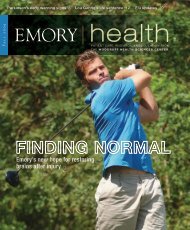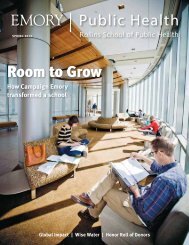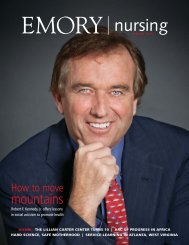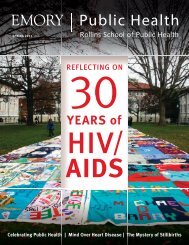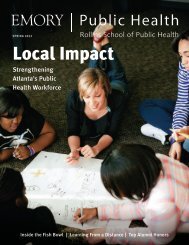returning quality to life - Woodruff Health Sciences Center - Emory ...
returning quality to life - Woodruff Health Sciences Center - Emory ...
returning quality to life - Woodruff Health Sciences Center - Emory ...
You also want an ePaper? Increase the reach of your titles
YUMPU automatically turns print PDFs into web optimized ePapers that Google loves.
Giving voice for a cure<br />
After his second relapse of acute myelogenous leukemia, Jeffrey<br />
Horne would spend late nights in <strong>Emory</strong> University Hospital<br />
talking with his mother, Nancy. One night he <strong>to</strong>ld her, “You know,<br />
Mom, God has a plan. It may be that I will get well, and I’ll be able<br />
<strong>to</strong> help others who have this disease. And it may be that I won’t get<br />
well, and then you can help them.”<br />
Jeffrey died on January 30, 2008, when he was 20. Nancy Horne<br />
is trying <strong>to</strong> honor his wish. She has established Jeffrey’s Voice, a charity<br />
that seeks <strong>to</strong> find a cure for leukemia and other blood cancers. In<br />
less than a year, Jeffrey’s Voice has raised and donated $50,000 <strong>to</strong><br />
Brian (left) and Jeffrey Horne shared everything—bikes as children,<br />
football in high school, and bone marrow as young men.<br />
<strong>Emory</strong>’s Winship Cancer Institute <strong>to</strong> fund leukemia research.<br />
“There are no known causes for this horrible disease and no way<br />
<strong>to</strong> prevent it,” says Horne. “That is why research is so important.”<br />
Horne got her education in leukemia the hard way. She now<br />
knows that these blood cancers seem unrelated <strong>to</strong> heredity.<br />
Circulating throughout the blood stream, they can strike anywhere,<br />
and even with aggressive courses of chemotherapy and radiation,<br />
they can hide out anywhere in the body. The chemotherapy used <strong>to</strong><br />
treat them is administered frequently and aggressively in an attempt<br />
<strong>to</strong> destroy the immune system and rid the body of the cancer.<br />
Jeffrey’s leukemia appeared out of the blue in February 2007<br />
when he was a junior at Georgia Southern University. With a sus-<br />
picion of leukemia, his local doc<strong>to</strong>rs sent him home <strong>to</strong> Atlanta for<br />
more thorough testing at <strong>Emory</strong>. He got the diagnosis on Tuesday,<br />
March 5. It was his birthday.<br />
Brian, Jeffrey’s younger brother, also came home from college<br />
<strong>to</strong> be nearby. And Brian’s bone marrow turned out <strong>to</strong> be a perfect<br />
match for Jeffrey, but there was a complication: Brian had a heart<br />
arrhythmia that was discovered while playing high school football.<br />
Doc<strong>to</strong>rs were concerned that the growth fac<strong>to</strong>r drug he would need<br />
<strong>to</strong> stimulate extra stem cells might overburden his heart. But Brian<br />
was determined <strong>to</strong> help save his brother’s <strong>life</strong>. Eventually, he got a<br />
chance <strong>to</strong> do so.<br />
Initially, the transplant seemed <strong>to</strong> work, and he went in<strong>to</strong> remission.<br />
He stayed away from crowds <strong>to</strong> avoid exposure <strong>to</strong> illness,<br />
but he was able <strong>to</strong> register for online classes at Georgia Perimeter<br />
College. He was trying <strong>to</strong> get back <strong>to</strong> normal, or as his mom says,<br />
the “new normal.”<br />
Several months passed before the small red bumps that looked<br />
like mosqui<strong>to</strong> bites appeared on Jeffrey’s legs. “We knew then that<br />
there was a problem,” Horne says. “The leukemia had been hiding<br />
out in his skin.”<br />
His <strong>Emory</strong> team started another round of treatment. He participated<br />
in two clinical trials, writing in his journal, “This next treatment<br />
is another experimental one and probably of no use <strong>to</strong> me, but<br />
I don’t mind being a lab rat if it will help other leukemia patients.”<br />
Again Brian stepped up <strong>to</strong> volunteer as a donor for a lymphocytic<br />
transplant, but Jeffrey became <strong>to</strong>o ill just before Christmas<br />
2008 <strong>to</strong> undergo the procedure. Then four months later, Brian also<br />
died. The cause, says Horne, was a broken heart.<br />
These three years later, the example set by Horne’s sons give her<br />
the strength <strong>to</strong> keep going. Supported by her husband of 40 years,<br />
Claude, and her remaining son Allyn, she is giving voice <strong>to</strong> Jeffrey’s<br />
and Brian’s desires <strong>to</strong> find a cure for leukemia. Donors such as UPS—<br />
for which both boys worked during two Christmas seasons—have<br />
enabled Jeffrey’s Voice <strong>to</strong> make headway against leukemia.<br />
Horne is committed <strong>to</strong> working with Winship <strong>to</strong> keep that<br />
momentum going. “I am so pleased now <strong>to</strong> be able <strong>to</strong> work with<br />
<strong>Emory</strong> on finding a cure.” —Rhonda Mullen<br />
WEB CONNECTION To support cancer research at Winship, contact<br />
Vicki Riedel at vriedel@emory.edu, 404-727-5939, or visit cancer.<br />
emory.edu. See also jeffreysvoice.org.<br />
Winter 2011 23



